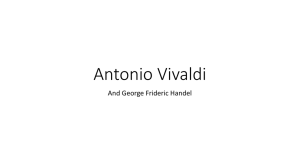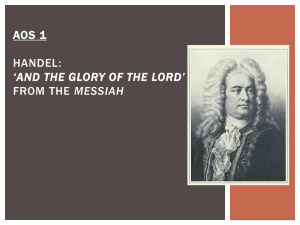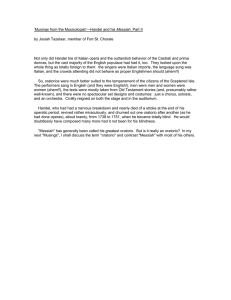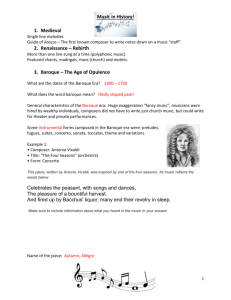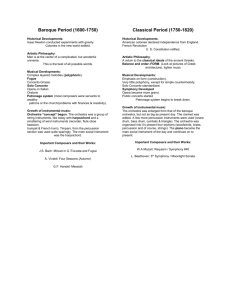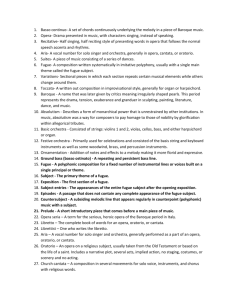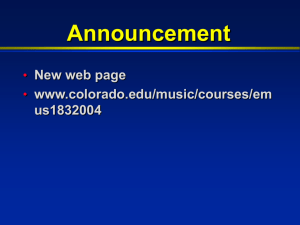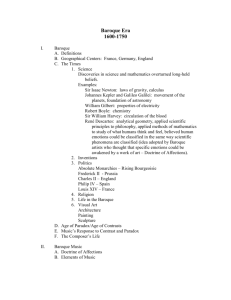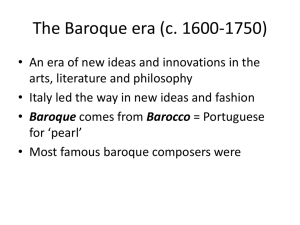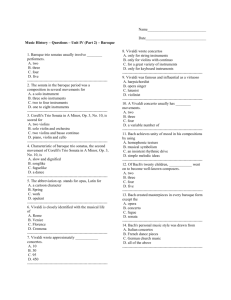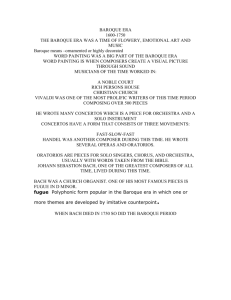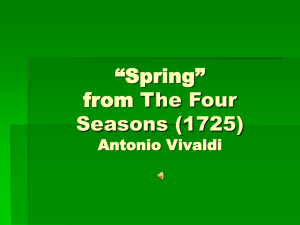Lecture 11
advertisement
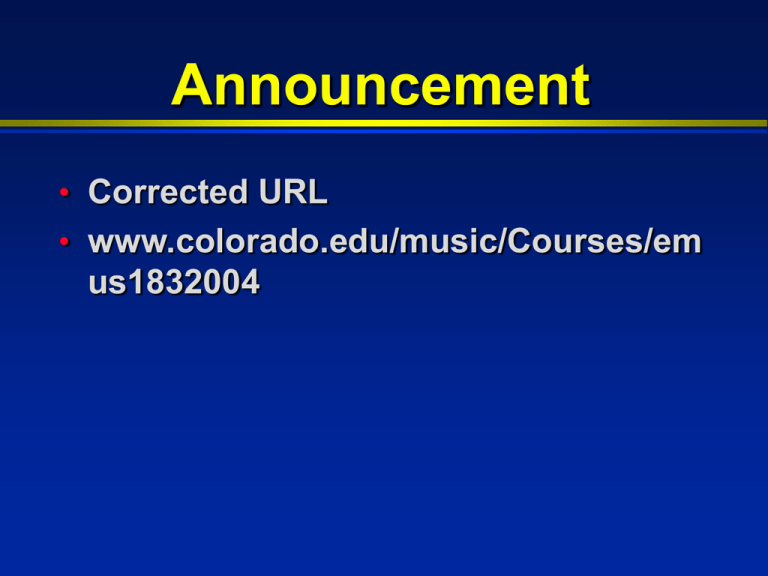
Announcement • Corrected URL • www.colorado.edu/music/Courses/em us1832004 Exam on February 25 • Will cover Medieval, Renaissance, and Baroque period • Will also cover some basic musical terminology • Listening examples (refer to GUIDES not CD tracks): 2, 3, 5, 7, 8, 9, 12, 15, 16, 17, 18, 20, and 21 • Bring a #2 pencil Oratorio • Definition: a work for chorus, vocal soloists, and orchestra on a sacred subject (usually Old Testament stories) • Many of Handel’s were in English • Most famous: Messiah • Written for a charity concert in Dublin, Ireland Handel’s Messiah • written in 1742 • Not a typical oratorio because it doesn’t tell a single story • in three parts, each articulating a part of Christian doctrine. • Christmas- prophesy • Easter- suffering and death, Resurrection • Redemption Messiah: first excerpt • (skip the overture-start your listening at track 21) • Chorus “glory to God” • Preceded by recitative (first with basso continuo, then with orchestra) • Examples of text painting in chorus? Messiah: second excerpt • “Rejoice greatly” • Aria for soprano • Form ABA (with orchestra introduction) • Virtuoso singing • Listen for which words are emphasized • (Emphasis on certain words is a way of interpreting the text) Messiah: third excerpt • Famous “Hallelujah!” • Listen for the differences between homophonic texture and fugue • Fugue is an older style used for serious subjects, a musical symbol of tradition (eg. ”he shall reign forever and ever”) Antonio Vivaldi • Spent much of his life in Venice, Italy • Taught at a high-class orphanage for girls • Girls were highly trained musically • Wrote hundreds of CONCERTOS for them Concerto • Definition: work for soloist (or a group of soloists) and orchestra • Most of Vivaldi’s were written for his students to play • Most of Vivaldi’s were for stringed instruments, but he also wrote concertos for unusual instruments like piccolo and mandolin Concerto • Famous example: The Four Seasons • Group of concertos for violin • Intended to depict winter, spring, summer, and fall Vivaldi, ‘Spring” • From The Four Seasons • Form: alternating orchestra part (called RITORNELLO) with soloist part (called EPISODE) • Solo episodes depict scenes from spring: birds, brook, thunder Keyboard Music • Elizabeth C. Jacquet de la Guerre • (1668-1733) • Prodigy on the Harpsichord (a Baroque The ELEMENTS of MUSIC • • • • • • • p.5 MELODY RHYTHM HARMONY TEXTURE DYNAMICS/TEMPO FORM TIMBRE INSTRUMENTS Families of the Orchestra • STRING • WOODWIND • BRASS • PERCUSSION p.9 Medieval (c.500-1450) • Chant (Haec Dies) • Organum (Haec Dies) • Motet (O mittisima/Virgo/Haec dies) RENAISSANCE: Sacred • Motet: Ave Maria … Virgo serena by Josquin Deprez • Mass: Pope Marcellus Mass (Gloria) by Giovanni Palestrina RENAISSANCE: Secular • ITALIAN MADRIGAL • A un giro • by Claudio Monteverdi • ENGLISH MADRIGAL • Fair Phyllis by John Farmer Baroque Instrumental Genres • Prelude & Fugue: Bach • C minor, from “Well Tempered Clavier” bk.1 • Suite: Jacquet de la Guerre • 2nd Gigue, Suite 1 “Pièces de Clavecin” • Concerto: Vivaldi • “Spring” from “The Four Seasons” Baroque Vocal Genres • Opera: Purcell, “Dido and Aeneas” • Oratorio (“Handelian”): Handel,“Messiah” • Cantata (Lutheran): Bach, “A Mighty Fortress is our God”
